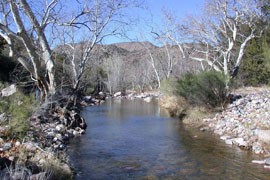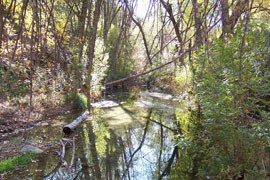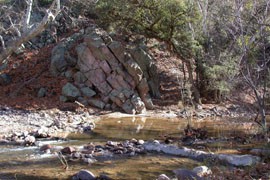Cronkite News has moved to a new home at cronkitenews.azpbs.org. Use this site to search archives from 2011 to May 2015. You can search the new site for current stories.
After years of struggle, opponents still fighting Pinto Creek mine
WASHINGTON – Don Zobel was at home on his computer when he read the news: The Supreme Court had sided with him after more than a decade of fighting to stop the Carlota Mine at Pinto Creek, near Globe.
“Wow, you know? It felt good,” Zobel said. “We finally won. We had a lot of other legal challenges and never prevailed, but we finally prevailed, and it was a big deal at the time.
“Or at least it seemed to be.”
Seemed to be, because three years after the Supreme Court refused to hear the Carlota Mine case, handing Zobel an apparent victory, the only thing that has changed at the mine is the company extracting the copper.
Mining began a month before the high court decision that so excited Zobel and it has not stopped since. The mine’s owners adjusted their operations plan so that it complied with regulations and court rulings, said an official with the Arizona Department of Environmental Quality.
“Our compliance inspectors have been out there many, many times,” said Linda Taunt, deputy director of ADEQ‘s water-quality division. “We have not found them in violation.”
The mine’s opponents disagree. They say Carlota is not in compliance and continues to act as if the court case had never happened.
“We won the Supreme Court, but the regulatory bodies just ignored the ruling and allowed them to go right ahead and destroy the area,” Zobel said.
The mine’s owners declined to comment on the fight, now almost two decades old.
A “spectacularly beautiful desert creek”
The fight began in the early 1990s, when residents and environmentalists first became alarmed at plans that called for the Carlota Mine to displace an entire mile of Pinto Creek to construct an open pit.
“Pinto Creek is a spectacularly beautiful desert creek,” said Don Steuter, a longtime opponent of the mine and the conservation chair of the Sierra Club‘s Grand Canyon Chapter. It “is one of the last remaining examples of what desert creeks should look like. I mean, it’s just spectacular.”
The creek west of Miami, Ariz., starts south of Highway 60 and runs 30 miles through the Tonto National Forest before emptying into Roosevelt Lake.
“Pinto Creek was one of the few, last free-flowing streams from source to the lake, and it went through a very . . . scenic nice area,” Zobel said. “They wanted to destroy this area for a very short-term, limited project.”
No less an Arizona icon than former Sen. Barry Goldwater cited the need to preserve the creek, after it landed on a list of the nation’s most endangered waterways in 1996.
“Maybe we need copper, but we also need exceptional places like Pinto Creek,” the Arizona Republic quoted Goldwater as saying. “We’ve lost a lot of little gems like Pinto Creek in Arizona over the years for various reasons. How many more can we afford to lose?”
Original plans called for the mine to discharge copper into Pinto Creek, which was already impaired by the metal. Because of the proposed creek discharge, the mine needed a permit from the Environmental Protection Agency certifying that the project met standards under the Clean Water Act.
Opponents worried that the mine would destroy the area, and that high copper levels in Pinto Creek would harm its aquatic life, but they could not act until the permit – a National Pollutant Discharge Elimination System permit – was issued.
The permit was issued in 2000 and the opponents began mounting challenges, eventually ending up in court with their fight.
In 2007, the 9th U.S. Circuit Court of Appeals vacated the NPDES permit, ruling that the EPA incorrectly allowed discharge of a pollutant into water already impaired by that pollutant. The court said the Clean Water Act requires that any permit include a plan to actually improve polluted waters, not just maintain them.
“Do we allow people to add more pollutants to (impaired waters) or do we clean them up?” asked Roger Flynn, the attorney who argued the case for the Friends of Pinto Creek. “That was the main issue.”
Two years later, the Supreme Court declined to hear an appeal of the 9th Circuit ruling, handing Zobel an apparent victory and potentially raising environmental protections for the country’s more than 41,000 impaired waters.
“We were going up against $500-an-hour attorneys and all we had was Roger (Flynn), and Roger won,” Zobel said.
The ruling’s impact – elsewhere
Some believe the ruling in Friends of Pinto Creek v. EPA has affected the way EPA and industry lawyers approach such cases.
“Pinto Creek has had an enormous influence on water-quality policy, I think, nationwide,” said Rick Parrish, a senior attorney at the Southern Environmental Law Center. “I consider it one of the most important Clean Water Act decisions ever.
“Regulators and dischargers and environmental groups are all significantly attuned now in the wake of the Pinto Creek decision,” he said.
Craig Johnston, a professor at Lewis and Clark Law School in Portland, Ore., notes that only a handful of cases have cited Pinto Creek. But he said that may be a sign the EPA changed its procedures after the decision.
“I think EPA is very aware of this opinion nationally,” he said. “At least until EPA decides what to do about it nationally, I suspect it’s saying, ‘Let’s live with it, and let’s follow it.’”
But while the Pinto Creek ruling may have had an effect elsewhere, it had little apparent impact on Pinto Creek.
“We thought that they would have to have a permit . . . and that that would trigger a cleanup,” Steuter said. “But they avoided that.”
Between the time that Carlota applied for its permits and the time of the circuit court decision, the EPA largely handed the responsibility for issuing and enforcing water permits over to the states. And the Carlota Mine reworked its plan, building impoundments to retain wastewater instead of discharging into Pinto Creek.
“As long as a facility doesn’t discharge, theoretically it could operate,” said Taunt, of ADEQ. “That’s what Carlota is doing, is trying to internalize all of their discharges. All of their discharges go back to the pit essentially.”
She said state inspectors have checked the site multiple times and have only found discharges into Pinto Creek tributaries – Haunted Canyon and Powers Gulch - which are permitted.
The mine now operates under a Multi-Sector General Permit, issued in 2000 by the EPA and up for renewal now with the state. Taunt said the state expects to send a letter shortly renewing the MSGP permit, but that there have been some concerns, the biggest being whether the mine is discharging wastewater from points that were not approved in the 2000 permit.
Taunt said it is unlikely that all the discharge points on the new application will be approved, “so we just need to make sure that we tell them the ones that are. And then they’re going to have to do probably what they did before and make large impoundments in these other ones to make sure they never discharge.”
Another concern is the temperature at which Carlota pumps water back into Haunted Canyon.
Carlota pumps water from wells at Haunted Canyon for mine operations. Because that can reduce Pinto Creek flows, the mine has to pump the used water back into Haunted Canyon, and that water eventually flows to the creek.
“At certain times of the year that pumped water is warmer than the ambient stream temperature,” Taunt said. “So we need them to do something to make it more like the stream temperature so it doesn’t cause any more problems.”
Another fight, or a moot point?
For mine opponents, who thought the circuit court ruling would lead to a cleaner Pinto Creek, the continued operation of the mine has been a disappointment. They believe the state has been too lenient and has given Carlota too much time to comply with standards.
“Who knows if the EPA would have done a better job – we’ll never know – but ADEQ, obviously, we feel is not enforcing the law properly,” Flynn said. “They have to protect the stream, and that’s what they’ve been dragging their heels on.”
Flynn, who first raised concerns about the Haunted Canyon water-temperature issues last July, now charges that the state is letting the mine pump the put-back water without a permit. He argues that the mine needs an NPDES permit for the put-back water, but that state officials “just ignore it, and look the other way in hopes the mine will continue.”
“They have yet to enforce the 9th Circuit’s decision,” Flynn said. “They’ve been dragging their heels.”
Taunt agrees that pumping put-back water is not covered by the 2000 permit, but she said the state does not believe that requires an NPDES permit.
“It’s surface water to surface water as far as we’re concerned,” Taunt said. “It has very low levels of copper, if any, so it’s well below the surface-water standard. So we’re looking at authorizing it as an ancillary discharge.”
Taunt said that even though opponents are “disappointed that the mine is operating,” the state is doing its job, by inspecting and interacting with Carlota and the other mines in the Globe area.
“Our role is to make sure they’re operating within the permits we issue. That’s our job,” she said.
In the meantime, opponents are waiting for the state’s next move before they decide what to do, which could include filing another lawsuit.
“We’re waiting to see what Arizona does about all these permitting issues . . . if ADEQ ever gets around to issuing these permits,” Flynn said. “They’ve been dragging their feet for years to avoid having Carlota comply with the law.”
But any action at this point may be moot.
Quadra FNX, the company that took control of the Carlota Mine from Cambior Inc. in 2005, said in its 2011 annual report for Carlota that it plans to end mining operations there in 2013. Quadra FNX was acquired earlier this year by another company, KGHM International.
In the last two years, more than 30 million pounds of copper were extracted from Carlota, bringing in almost $200 million in revenue, the annual report said. But it reported an operating loss of $66.8 million as a result of production costs and other expenses during that two-year period.
While pleased with the news that mining could stop in 2013, for Carlota’s opponents “the damage is done.”
“They took this pristine area . . . for a little bit of copper, only half of which they ever got,” Zobel said.










